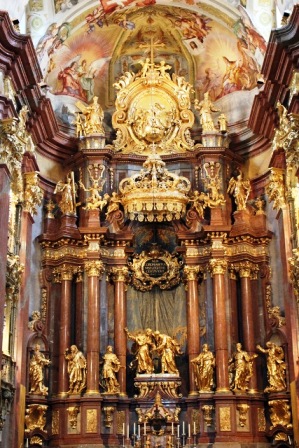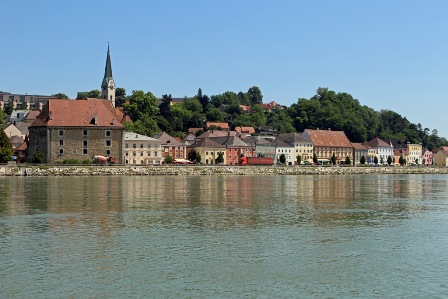|
Day 3 Linz to Tiefenbach
Tuesday June 10 2014
The difference between our previous 3 star hotels
and a 4 star hotel, as was the Speigenberger, was the smoked salmon on
the breakfast buffet. There was enough for me to make a supper lunch
sandwich. Yum.
We set off from the hotel before 9AM, as usual,
and rode about 69 km, but we made better time. We were choosing the less
travelled sides of the river each day, avoiding paths that were next to
the busier roads. Surprisingly, we only encountered many other
bicyclists on the first half of the first day. Otherwise we passed or
were passed, groups of two or four cyclists every now and then, many
carrying their own gear in panniers, the others relying on services to
carry their luggage, as we were. Our promised hoards of bicyclists never
materialized. Only when we arrived at our hotels did we realize there
were many other people following the same route as we were. It often
seemed we had the paths to ourselves.
Our route on Day 3 had us
crossing a bridge in Linz to the north side of the Danube and riding
along a path on a dike in parkland right next to the water. At
mid-morning we crossed to south side on top of a dam at Abwinden and
made a detour to the historic city of Enns, reputedly the oldest town in
Austria, for our coffee break. Enns was easy to find. It is dominated by
a tower, erected between 1564 and 1568 as a bell tower, watch and clock tower
during the reign of Emperor Maximilian II. The tower was on a hill, which meant we
climbed and pushed our bikes up a steep cobbled street to the town
square to photograph the clock tower.
The town promised several interesting churches
but we skipped them to retrace our route to the river where we found a
ferry to take us back to the north side of the river. We were on the
dikes again and it was warm. We found a picnic bench beside the river
and dragged it into the shade of some bushes to enjoy our picnic lunch.
A bit farther along we were able to refill our water bottles and buy a
bottle iced tea to rejuvenate ourselves for the remainder of the trip.
Our hotel, Gasthof Zur Danaubrücke, was on the south side of the Danube,
at the end of a bridge spanning the river, just 2 km before thehamlet of
Tiefenbach and 2 km across the river from Grein . For the first time, we
arrived before our bags. There was nothing to do but have a beer on the
pleasant terrace and relax.
Day 4 Tiefenbach to Spitz
Wednesday June 11 2014

Melk Abbey Church
If we thought St
Stephen’s Cathedral was over-the-top Baroque, we hadn’t counted on the
Benedictine Abbey church in Melk. No wonder the town was full of
tourists, all coming to see this sumptuous complex. We had ridden about
all morning to get to Melk with just a few stops to photograph a few of
the castles perched on hilltops and to eat our picnic lunch. The
original abbey was founded in 1089 and rebuilt to Baroque perfection in
1702-38. The riot of gold and beautiful frescoes in the church, and an
impressive library of 100,000 medieval manuscripts have made the Abbey one
of the best-known abbeys in Europe.
Even fighting large cruise boat and bus tour crowds didn’t spoil our
enjoyment. The extensive gardens were an added treat with the roses in
full bloom. There were woodland paths to explore with period music from
speakers hidden in the trees to sooth the soul of visitors.
The cruise ships and barges on the Danube all
have to go through several locks to complete their journey. It is always
interesting for us to watch the large ships maneuver through without
incident. Just after we left Melk, a cruise ship was entering a lock
going downstream. We rode to the other side of the lock to see a double
width ship approaching the lock from the other direction. Following the
larger boat upstream was a small houseboat, hoping to fit into the lock
with the larger boat. That was not to be. Cruise boats are often
designed to the maximum size the locks will hold. The house boat docked
on the side of the river to wait their turn. The cruise boat took all
the space in the lock.
We continued on, crossing
to north shore on a cable drawn ferry at Arnsdorf, across the river from
Spitz, our destination for that night. In a small passenger lounge of
the ferry was a Camera Obscura by Icelandic artist Olafur Eliasson
installed to mark the entry of the Wachau region into the UNESCO list of
World Cultural Heritage Sites in 2004. What you see is a real-time view
of what is happening on both shores.
With a system of lenses and mirrors, images are displayed on 2 screens
on a wall of the darkened lounge room. Eliasson likens the principal of
the camera obscura, which was know even to Aristotle, to the technically
obsolete cable drawn ferry.
Hotel Wachauerhof, first documented in 1668, and
one of the oldest in the Wachau region, was just a few blocks away. The
hotel
has restored several intricately carved pillars and some lovely painted
chests in the corridors as a reminder of it history. We took advantage
of the pleasant backyard garden bar/restaurant for our post-ride beer
and dinner later. We have been very pleased with our accommodations on
this trip.
|
